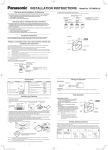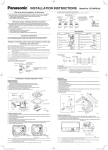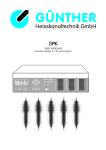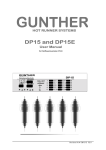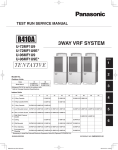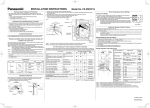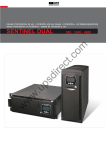Download Panasonic CZ-RWST1U Installation Manual
Transcript
INSTALLATION INSTRUCTIONS Warnings about Installation of Receivers The wireless remote uses a very weak infrared light for its signal, which can result in the signal not being received because of the following influences, so take care in where the unit is installed. • Inverter or rapid-start type fluorescent lights. (Models without glow lamps) • Plasma display or LCD televisions. • Direct sunlight or other sources of bright light. Model No. CZ-RWST1U If a group of units are to be controlled by 2 remote controllers; ※ Main/sub remote controllers will work regardless of which indoor unit they are installed to. Cross-wiring Remotes for Group Control (Field Supply) Wireless Remote Controller ※ (Main) 㧯㧺㧝 㧝 㧞 Use wiring of AWG#20 – AWG#14 for field supply. Make the total wire length when crosswiring a group no more than 650 ft. Wired Remote Controller 㧝 㧞 ※ (Sub) Warnings about Installing Remote Controllers If a remote controller is to be operated from a remote control holder that is hung on a wall, turn on the lights in the room as well as any electrical appliances and then check to make sure the air conditioner works with the remote controller in the location where it will be installed. If it works, continue with installation. If the air conditioner is to be switched from the main sensor to a remote control sensor, pay attention to the following when installing. • Locate where no warm or cold drafts will affect it. • Locate in a place free from direct sunlight. • Locate where it will not be affected by any other heat/cold source. 1st Indoor Unit 2nd Indoor Unit 3rd Indoor Unit 4th Indoor Unit CZ-RWST1U Customer Explanation Give the Operating Instructions and this manual to the customer after finishing the installation. Use the Operating Instructions to explain to the customer how to use and care for the unit. S003 Bit 3: OFF→ON Things to remember when wired and wireless remotes are installed at the same time Two remote controllers can be used to control the unit if the wireless remote controller is installed at the same time as the wired remote controller. (Up to 2 remotes [a wireless remote controller and the wired remote controller] can be installed.) When using 2 remotes, one or more units can be operated by the remotes. <Note> When wiring remote controllers, be sure to double-check the terminal numbers of the indoor unit before connecting them so there are no mistakes in the wiring. (Damage will occur if high voltage [e.g. supply voltage] is applied.) <Note> It is not possible to use more than one wireless remote controller with one indoor unit. (A receiver located separately can be used at the same time.) <Note> If both a wireless and a wired remote controller are to be installed and used at the same time, one of them must be set up as the sub remote controller. If the wired remote controller is to be the sub remote, change the wired remote controller to the sub remote. If the wireless remote controller is to be the secondary, turn the #3 switch on the wireless receiver (operation panel) from OFF to ON. When 1 indoor unit is operated by 2 remote controllers: ※ Either of the remotes can be set to main/sub. Wired Remote Controller (Sold Separately) ※ (Sub) ※ (Main) Wireless Remote Controller 㧯㧺㧝 㧝 㧞 Receiver 㧝 㧞 Use wiring of AWG#20 – AWG#14 for field supply. Use a total wire length of no more than 1300 ft. Remote Control Wiring (Field Supply) Indoor Unit 1 2 1-Way Cassette Type Accessories No. 1 Accessories Quantity No. 1 4 Dry-cell Batteries 2 5 Operating Instructions 1 Receiver Accessories Quantity 2 Remote Controller 1 6 Truss Self-Tapping Screws 2 3 Remote Control Holder 1 7 Cable tie 1 1 While spreading the tabs of the cover, pull it out from the panel to the front. (Fig. A) 2 Pass the lead wire through the panel and install the receiver in the hole in the panel. (The projecting parts of the receiver hold it in the hole in the panel.) 3 Press the lead wire from the receiver in along the rib on the back of the panel. If installing to a unidirectional high ceiling cassette, pass it through the cutout. (Fig. B) 4 Install the panel on the indoor unit. 5 Fasten the lead wire sticking out from the panel with the cable clips on the inside of the indoor unit. (Fig. C) 6 Draw the lead wire into the electrical box through the hole on the bottom and connect it to the remote control terminal strip. If installing to a high ceiling unidirectional cassette, fasten the wire at the latch of the fan casing with the enclosed cable tie. (Fig. D) Fig. A Installing the Receiver Spread Fig. B High ceiling unidirectional cassette (Back of the panel) Ceiling Type 1 Open the air inlet grill on the side panel, remove the 1 screw and then move it toward the front (direction of the arrow) and remove it. (Fig. A) 2 Wrap the tip of a slotted screwdriver with plastic tape and then slip it in to the side of and under where O is printed on the cover, wiggling the cover free. (Fig. B) (Be careful not to scratch the panel.) 3 After passing the lead wire through the panel, install the receiver in the hole in the panel. (The projecting parts of the receiver is held in the hole in the panel.) 4 Fasten the receiver’s lead wire to the cable clip that is holding the wire from the louver motor. (Fig. C) 5 Attach the side panel. 6 Put the receiver’s lead wire together with other wires, such as the louver motor wire and fasten them with the wire saddle. (Fig. D) Use the hole in the upper part of the wiring box to lead it in. Fig. A Fig. B Slotted Screwdriver (Wrapped with Plastic Tape) Side Panel Pull off to the front. Cover Spread Press the lead wire in. Receiver Press the lead wire in. Rib Fig. C High ceiling unidirectional cassette Unidirectional ceiling cassette Receiver Rib Cutout Fig. D Unidirectional ceiling cassette Fan Casing Panel Fasten at the latch of the fan casing with enclosed cable tie. Plastic Tape Cable clips Cover Slip in to the side and below the O mark Air inlet grill Wire saddle Fig. C Fig. D <Note 1> If the wiring for the receiver is bundled with other wires, such as the incoming line, it may cause a malfunction, so avoid putting them together. <Note 2> Fasten the lead wire securely so it does not get wrapped up in the fan. <Note 3> If something causes the unit’s power source to make noise, it will be necessary to resolve the problem, such as by installing a noise filter. For more information about wiring or test operation, refer to Wiring the Receiver and Test Run. Cable clip Wiring the Receiver Wiring Diagram Indoor Unit Terminal Strip for Wiring Remote Controllers Receiver Panel 3 Panasonic_INST MANUAL_CZ-RWST1U.indd 1 Receiver PCB %0 White Black 2P White Connections Connect the wires from the receiver to the remote control terminal strip on the indoor unit. (Polarity does not matter.) 4 2012/01/20 15:23:57 The Self-Diagnosis Function Display and What is Detected Test Operation Implementing a Test Run 1. Turn the #1 DIP switch [S003] on the receiver’s PCB from OFF to ON and operate the wireless remote controller with its Start/Stop button. 2. During a test run, all display lamps on the display will light up. 3. During a test run, it is not possible to adjust the temperature. 4. After completing a test run, be absolutely sure to turn the #1 DIP switch from ON to OFF and make sure none of the display lamps are blinking. Also, replace the PCB cover back as it was and fasten it; while holding the wiring with the cable clamp, tighten its screw. S003 Bit 1: OFF→ON <Note 1> This is hard on the device, so only use this for the test run. <Note 2> After turning on the power, the unit will not receive any commands from the remote controller for about 1 minute. This is not an error. (In fact it does receive signals, but they are cancelled.) Alarm Display in the table below indicates the content of alarms that are displayed when a wired remote controller is connected. For information on how to deal with the alarms, refer to the Mounting Instructions for the indoor unit or to Test Run or servicing materials. Error Detected WL Remote Control LED Display Alarm Display Run Timer Standby Blinking Communication error in the remote control E01–E03, E08–E14, E17, E18 circuit E04–E07, E15, E16, E19–E31 Communication error either in the in/ outdoor operation line or the sub-bus of the outdoor unit Operation of indoor protection device P01, P09–P14 ◎ ● ● ● ● ◎ ● ◎ ◎ Alternately Operation of outdoor protection device P02–P08, P15–P31 ◎ ● ◎ Alternately Error in the indoor thermistor F01–F03, F10–F11 ◎ ◎ ● Alternately Error in the outdoor thermistor F04–F09, F12–F28 ◎ ◎ ○ Alternately Error in the indoor EEPROM F29 ◎ ◎ ● Simultaneously Error in the outdoor EEPROM F30, F31 ◎ ◎ ○ Simultaneously Error related to the compressor H01–H31 ● ◎ ● Error in indoor settings L01–L03, L05–L09 ◎ ● ◎ Simultaneously Error in outdoor settings L04, L10–L31 ◎ ○ ◎ Simultaneously Inconsistency in Air/Heat (Including an auto-temp setting for a model without auto-temp settings) Oil Alarm (Same as operation of outdoor protection device) ○ ◎ ◎ ◎ ● ◎ Test Run ◎ ◎ ◎ Alternately Alternately Simultaneously ● : Off / ○ : On / ◎ : Blinking (0.5 sec. intervals) Setting Address Switches Room Temperature Sensor Settings When more than one receiver and remote controller are installed in the same room, setting up addresses allows them to avoid interfering with each other. Refer to the Operating Instructions for information on how to change the addresses of the remote controllers. Changing the address of a receiver can be done after removing the screw to the receiver’s PCB cover. Once the change is complete, put the cover back in place; while holding the wiring with the cable clamp, tighten its screw. Address Display on the Remote Controller Position of the Receiver’s Address Switch ・・・・・ It doesn’t matter where the receiver’s address switch is. 㧝㧞㧟 㧠㧡㧢 㧝㧞㧟 㧠㧡㧢 㧝㧞㧟 㧠㧡㧢 ・・・・・ 5 Common to All Models The indoor unit and the wireless remote controller are equipped with indoor temperature sensors. The sensing of indoor temperature works via one of them. When the unit is shipped, it is set to the indoor unit, but to switch to the remote controller, press the sensor button (diagram at right) inside the remote controller’s cover and then check to make sure that Main Sensor on the LCD screen goes off. <Note> Even when the sensor switch has been set to the remote controller, if the unit does not receive any room temperature data from the remote controller for ten minutes, it automatically switches back to the indoor unit sensor, so be sure to install the remote controller facing the receiver. Sensor Button 6 Setting Up Remote Control Functions The functions of the wireless remote can be set on site. (These settings are saved in nonvolatile memory in the remote controller, so even when its batteries are changed, the settings do not revert to the defaults.) <Note> The operation of the air conditioner can be impacted, depending on the settings made, so only service personnel should make the settings. Furthermore, making changes to these settings may cause actual operation to deviate from what is printed in the Operating Instructions, so be sure to explain this to the customer fully. Making Settings (Do with unit stopped.) 1. Holding down the Swing/Wind Direction + OFF Timer + Mode Select buttons at the same time for 4 or more seconds makes the display switch to the setting screen. (See Diagram Below.) 2. Use the Temperature setting buttons, / , to select the number of the item to be set. 3. Use the ON Timer buttons, / , to change settings. 4. The settings are saved with the Once/Every Day button. When this is done, the settings display of the LCD changes from blinking to light. 5. If other settings are to be changed as well, repeat steps 2 to 4. 6. When all settings have been made, press the Start/Stop button. Example: Operation mode setting screen Item Number & Setting Item Item Number 1 Operation Mode 2 Flap Display Setting Content Setting when Shipped (No Display) (Note 1) 6 2 3 4 1 3 Select Fan Speed 4 5 Display of Set Temperature Time Display 6 Ventilation Fan ON/OFF Off (No Display) 7 Cool temp Max 8 Cool temp Min 41 – 95°F 64°F 9 Heat temp Max 41 – 95°F 78°F (Note 4) 10 Heat temp Min 41 – 95°F 60°F 11 Dry temp Max 41 – 95°F 86°F 12 Dry temp Min 41 – 95°F 64°F 13 Auto temp Max 41 – 95°F 80°F 14 Auto temp Min 41 – 95°F 62°F 16 Address Setting Max Value 00 (ALL only) (No Display) °F Setting Off (Note 2) AM/PM °C 24 Hour (No Display) AM/PM On OFF (Note 3) 41 – 95°F 86°F 01 – 31 17 Heat temp Max ON/OFF JP (Heater Max Temp Change Off) EP (On) Note 1 Note 2 Note 3 Note 4 Note 5 °F 06 (Note 5) JP While the unit is in the swinging mode (Swing/Wind Direction), the flap cannot be stopped in a desired position. When Setting OFF is selected, “°C” is displayed on the LCD screen. You can toggle between ON and OFF by pressing Ventilation for 4 seconds or more. If the Heater Max ON/OFF setting is not changed to EP (ON), the setting change will not be reflected. This is the number of addresses that can be set in the address change mode. Do not set it to 07 or above. Printed in Japan 7 Panasonic_INST MANUAL_CZ-RWST1U.indd 2 8 85464369522011 2012/01/20 15:23:59


